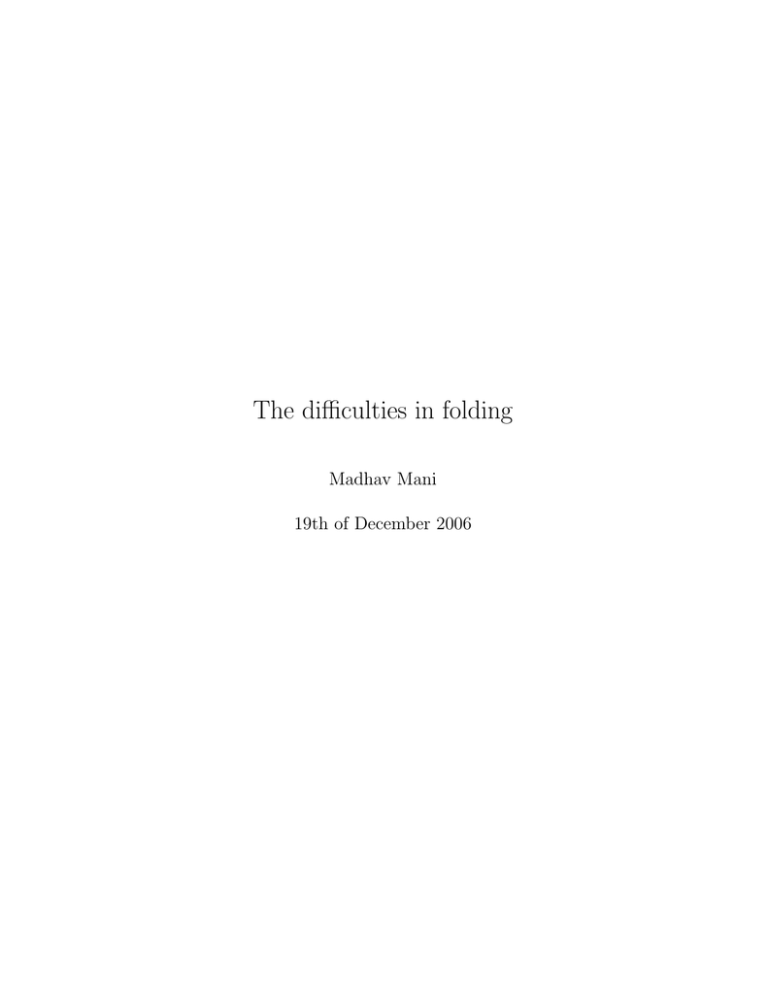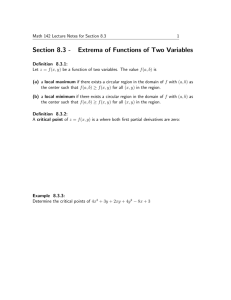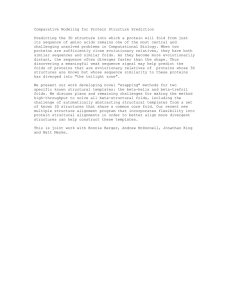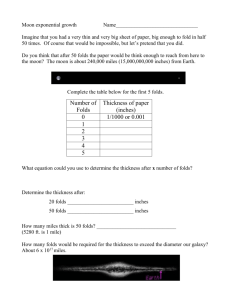The difficulties in folding Madhav Mani 19th of December 2006
advertisement

The difficulties in folding Madhav Mani 19th of December 2006 Chapter 1 Some theory The study of large deformation behaviour of solids is difficult, owing to the complications associated with the combined effects of geometrical and material non-linearities. This coupling is reduced naturally in the study of thin elastic sheets and filaments, which can withstand large strain while still being in the linear elastic regime. This occurs due to the separation of scales, that is, the large difference between the thickness and length of the sheet[1,2]. In many cases thin sheets can and do deform elastically and reversibly with large deflections on the order of the system size. Two observations of such deformations must be made: the sheet is rarely homogeneously deformed and the sheet can also fold to such an extent that regions that are initially well-spaced can come into contact. The inhomogeneities in the deformation field can lead to localization of strain. Furthermore, contact problems involving a non-local constraint complicates the search for solutions of the equations of elasticity both analytically and/or numerically which are otherwise local [3]. The following paragraph is a reminder of the basic physics associated with deformation of a thin, isotropic, homogeneous, naturally flat sheet. The sheet has two primary modes of deformation: out-of-plane bending and in-plane stretching. If the sheet has a thickness h, bending deformation produces strains of the order γB ∼ κz at a distance z along the normal to the middle surface (which is invariant under bending). The elastic energy associated to R pure bending is UB ∼ dzγB2 ∼ h3 . Stretching on the other hand occurs homogeneously, that is, the same along any surface we wish to cut along. So theR elastic energy associated with pur bending through a cross section is US ∼ dzγS2 ∼ h. The total energy for the elastic surface can be written as 1 (Rayleigh 1922) energy = h3 (bending) + h(stretching) (1.1) Note however the importance of boundary conditions associated to the deformation of a sheet. Imagine taking a piece of fabric and stretching it with you hands, its apparent that the sheet is being stretched and if you stretch too much then wrinkle patterns appear parallel to the direction of the stretch [7]. However, if you compress the fabric then you don’t see the ”excess” material being compressed, in fact you see the fabric buckling and respond by bending. Hence the importance of boundary conditions is clear and this again makes the system analytically and numerically difficult. A ”table-top” experiment the reader can conduct is the following. Drape a large circular sheet over a circular table. Take a note of the pattern of folding in a certain region of the sheet. Now tap the sheet reasonably hard, the arrangement of the folds will often change. This shows that the sheet is comfortable in several states. From a purely statistical point of view this is realization of the fact that a macrostate of a system can be mutually achieved by several microstates. This however implies the computationally this is a very difficult problem and as of yet this hasn’t been achieved. Another experiment that the reader can conduct is one where the circular sheet is slightly bigger than the table it is covering. The experimenter would notice that there are no fold. This implies that there is at least one length scale set by the material properties, global and local geometries, past which we see folds. The following paragraph refers to length scales derived elsewhere. The following scaling laws are derived when considering the ”draping of a point” when a thin heavy circular sheet of thickness h, and radius R, made of an isotropic material of density ρ, Young’s modulus E, and Poisson ratio ν is suspended from its center [3]. The number of folds is determined by the size of the sheet in proportion to the weight of the sheet. In such conical sheets, the Gauss curvature (the product of the curvatures in two orthogonal local cartesian coordinates) is localized to a small neighborhood of the tip, or in the case of a circular table-cloth on a circular table it is localized to the edge of the table. So the stretching of the sheet can be neglected in the region of the folds. The bending and stretching strains become comparable for a critical system size RS ∼ (Eh/ρg)1/2 . (1.2) So for cases R less than RS we can neglect stretching. However, even for the case when R greater than RS stretching is important only in regions near the 2 supporting points and/or curves where the tension is the largest. Similarly balancing the bending and stretching energy of the system the following natural length scale appears [3] lg = (B/hρg)1/3 (1.3) where B is the bending stiffness B = Eh3 /12(1 − ν 2 ) (1.4) Hence when the sheet radius R/lg >> 1, a large number of folds is the result. The following explanation is the crux of the arguement for the appearence of folds. Referring to the picture the gravitational energy can be minimizes by reducing the azimuthal deflection angle β, but this process increases the number of folds (due to the inability of a sheet to accomodate excess material in-plane), this in turn increases the bending cost. So the result is an optimum number of folds minimizing the total energy. The optimum number of folds for the case of a thin heavy circular sheet draping a circular table is the following (reference to elements of draping) n ∼ (R/lg )1/4 (1.5) The reader can either chose to verify this formula themselves or refer to the paper above. 3 Chapter 2 Finite element modeling Unswayed by the warnings in all the literature regarding the complexity of modeling the folds in a thin elastic sheet the author made several attempts. The following section is regarding how the system was modeled in ABAQUS and subsequently how the model faired in replicating the folds seen in physical experiments. Lastly comments will be made on what improvements can be made to the model. The modeling was done in consultation with Dr. Askhan Vaziri who seems equally perplexed as me. However, he kept reminding me that I have to stick to the physical model and see what the results are. There were times when I saw folds however the modeling was ”unphysical” and what I was seeing was mostly a results of bad modeling and numerical garbage rather than the folding pattern that we are looking for. We continue with working on this problem. Non-linear geometric effects had to be included in this analysis for the reasons in chapter 1, that is, the NLGEOM option was turned on. This had disastrous effects from the point-of-view of convergence and ABAQUS aborted every time with a failure due to too many negative eigenvalues and or the minimum time step (which was set to the ABAQUS minimum) was reached. One therefore had to use the Dissipated energy fraction option and set it to 2 × 10−5 this helped convergence. It also has the effect of acting like a perturbation to the system which aids in the system settling to a stable state. However, I am not convinced that the value used here is the optimum. A note to the reader is that this model does not seem to be taking into the account the comment made earlier that a sheet is ”comfortable” is several microstates. I experimented with different types of elements. Most of my modeling was done using shell elements in specific S8R, which is eight4 noded, reduced integration element. The reason for me using a parabolic (eight-noded ) rather than linear (four-noded) set of elements was simply due to the advise from several papers that I read regarding modeling thin fabrics. The shell thickness was set to 1/100ths of the radius of the sheet. The concept of homotopy or continuation was also essential. In small deformation problems where both the material and geometric effects are linear and local the loading in the problem can be turned on instantly. Convergence isn’t a problem in this case. However, in the case I was looking at for each time step several ”loading” steps had to be made, that is, a little bit of gravity had to be turned on the initially flat sheet was used as a guess for the boundary value problem and then the new deformed sheet was used as an initial guess for the slightly larger loading etc. Hence the number of computations involved were very large. The minimum possible value of a time step was used, that being 1×10−15 . The maximum number of increments were implemented. Often the model aborted due to the maximum number of increments being exceeded. The boundary conditions were simple. All components of displacement and rotations were set to zero at the ”edge” of the table. The loading was simply gravity on the entire domain. My results below will further elaborate the numerical journey however a key physical aspect which the model had to include was that a fabric buckles and bends rather than compresses to include the excess material. This was achieved by checking the No Compression option. I am not convinced this is the best way to model this aspect of fabric however I have seen no better as of yet. 5 Chapter 3 Results This section presents the different models that I have used and the varying success that they have met with. In all the pictures below I have used the following values of material properties and loading conditions. E = 1000, ν = 0.3, ρ = 1000, g = 1000 (3.1) The only parameter that I varied was the value of g. This is a valid parameter to vary, the justification of which is the scaling law below. lg = (B/hρg)1/3 (3.2) In all my calculation I kept h a constant. It was simply 1/200 of the length of the system (diameter in the case of a circular sheet). The importance of global geometry was clear in my results. The two graphics figure 4.1 and 4.2 below represent part of a square ”table-cloth” draped over a table. I therefore decided from this point onwards to always work with geometries which were ”closed” (see below). (figure 4.3) However, one can see the localization of stress, a possible singularity in the stress-field, occuring at the vertex of the table. I therefore decided to focus on modeling a circular table cloth on a circular table. This is also much better understood analytically [3]. Below is the output graphic of a circular table cloth with ratio 0.25, that is, the radius of the ”table is a quarter of that of the ”cloth”. Using the elementary scaling laws this ratio seemed small enough to see folds, that is, the weight of the sheet was large enough to overcome the sheets resistance to bending. (figure 4.4) 6 However, in this model I wasn’t using the no compression option in ABAQUS and it is clear that the sheet is accomodating the excess material simply by compression rather than bending out-of-plane. The next graphic is the output when the option is turned on. I do not understand whats going on here either. (figure 4.5) I have only recently begun an attempt to model the system with solid elements. This is in fact looking very promising. I seem to have got some folds developing in the thin sheet, however, I need to verify their validity. (figure 4.6 and 4.7) We see above the same effects that was seen earlier in the square situation because of the global geometry effecting the dynamics. However, we do clearly see the development of a fold. The graphic below is the ”closed” cased. 7 Chapter 4 Figures geometry shell.png Figure 4.1: Small global geometric effects 8 geometry shell large.png Figure 4.2: Effects negated table cloth.png Figure 4.3: ”closed” geometry 9 element circular table cloth.png Figure 4.4: Ratio = 0.25, Shell element elements no compression.png Figure 4.5: No compression, Shell elements 10 element quarter cirlce.png Figure 4.6: Solid elements, quarter circle elements circular table cloth.png Figure 4.7: Solid elements, Closed geometry, appearence of folds 11 Chapter 5 Conclusions It is clear that there is a lot of work to do. However, I feel that modeling the system as a thin solid rather than a shell might be fruitful. It is possible that this project was too ambitious but I have read some of the landmark books and papers on the subject of large deformation elasticity in trying to understand what is going on which was a great benefit of this project. 12 Chapter 6 Bibliography 1)Landau-Lifschitz: Theory of Elasticity, Third Edition: Volume 7 (Theoretical Physics, Vol 7) 2)A.E.H.Love: Treatise on the Mathematical Theory of Elasticity 3)Cerda, Mahadevan, Pasini: The elements of draping, PNAS, vol. 101 no. 7 1806-1810 4)Cerda, Mahadevan: Confined developable elastic surfaces: cylinders, cones and the Elastica, Proceedings of the royal society A, 461, 671-700 5)Cerda, Mahadevan: Conical surfaces and crescent singularities in crumpled sheets, The american physical society 6)Boudaoud, Chaieb: Singular thin viscous sheet: Physical Review E, Vol 64 7)Cerda, Mahadevan: Geometry and physics of wrinkling, Physical Review Letters, vol 90, no. 7 13







